Dinosaurs, Soaring Forests, and Giant Rivers
The Painted Desert is a beautiful and mysterious place. Perhaps its crown jewel is the Petrified Forest National Park, where one may encounter the largest known concentration of petrified wood on the planet, a pretty special distinction. From small shards to large trunks that are several feet in diameter, this natural phenomena dominates the stark, hauntingly beautiful landscape in northeastern Arizona.
The most fun part about being a geologist, or learning about geology, is the creativity and imagination in picturing how a landscape like the Petrified Forest came to be. Why is it here? The story told by the rocks and fossils in this wondrous place is one that winds through the sands of time, beginning nearly 225 million years ago in an era known as the Triassic……
The clock keeps on ticking…
As the years fly by, transporting us to this very place, we find ourselves standing in a towering deciduous forest. These trees, some perhaps 100m tall, dominate the skyline and provide a lush canopy of greenery for the local flora and fauna. We are close to the equator, inland on the supercontinent known as Pangea, formed when all the continents were sutured together by plate tectonics.
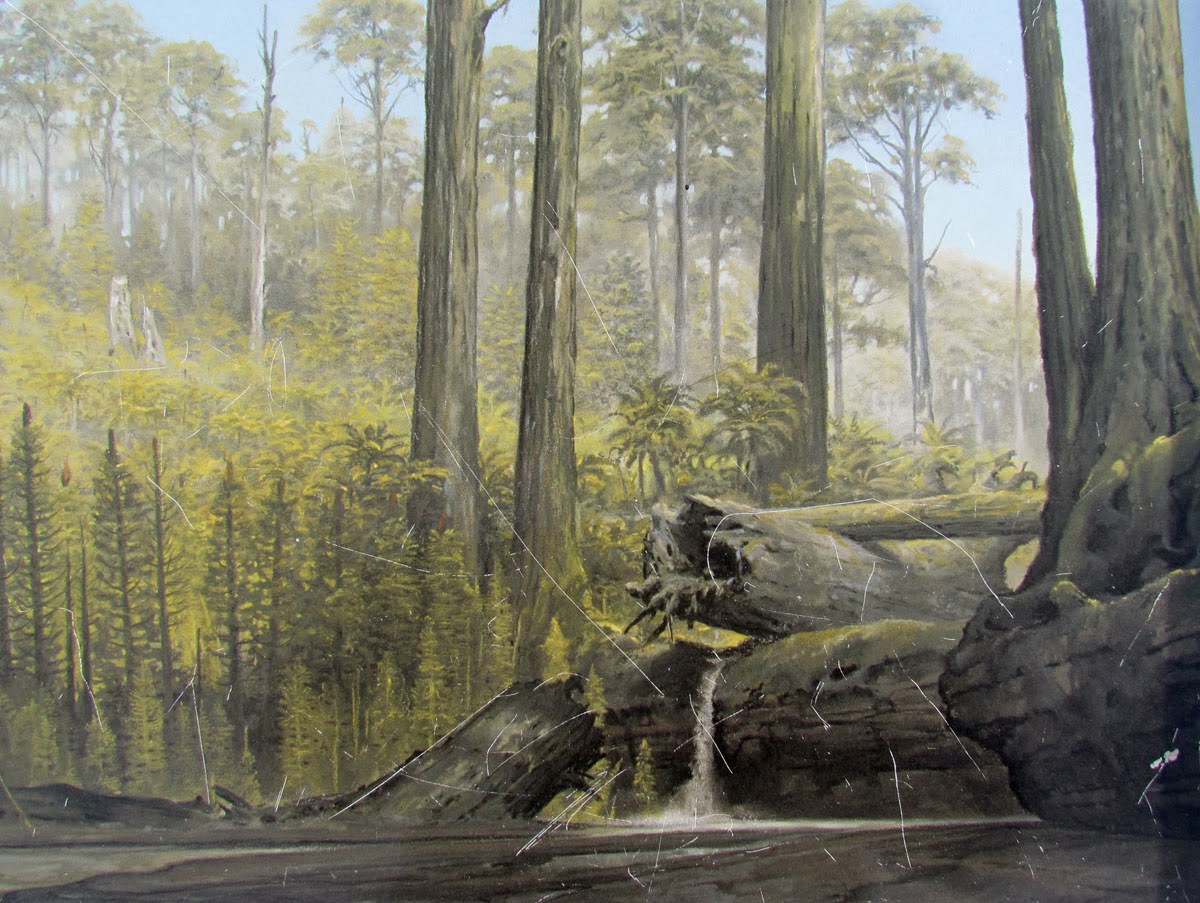
Artist’s rendering of a Late Triassic scence (courtesy geolhistory.com)
A giant dragonfly, one roughly the size of an adult males’ hand, swoops by, landing nearby on a fern in the swampy landscape. The vegetation is dense, the air is humid, and the smell in the air is a pungent mix of decaying organic matter and still water. We are in a sub-tropical jungle, similar to one you might find in modern day Central America, and it is quite hot. As we stomp though the brush swinging our machetes, we come to a clearing where a wide, shallow, lazy river is coursing its way through the forest, bound on each side by floodplains.
Wild Dinosaurs
Following the river we find tracks. What are they? Large Phytosaurs are fishing and sunning themselves on the bank of this warm river, while the other titan of the Triassic, Rauisuchian, steers clear. Many other smaller dinosaur-like reptiles and crocodilian vertebrates roam around the brushy banks and Pterosaurs circle in the air, looking for fish and small mammals.
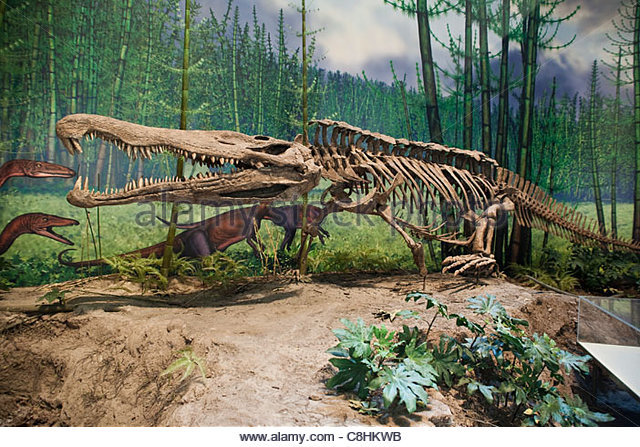
The Phytosaur, top predator of the Triassic
The scene is serene, peaceful. A warm, wet wind blows through the river valley, rustling fern leaves and wafting tree seeds. Though you may not want to go, time steps forward. Over the next 150 million years, this scene is buried by larger rivers, deserts, and lakes. Trees fall and muds and sands carried by the ever-coursing rivers of change bury the trees and dinosaurs, entombing them to one day rise again. Pangea rifts apart near the end of the Cretaceous and massive volcanic outputs combine with extra-terrestrial impacts to wipe the planet clean, giving rise the mammals that heretofore existed only underground.
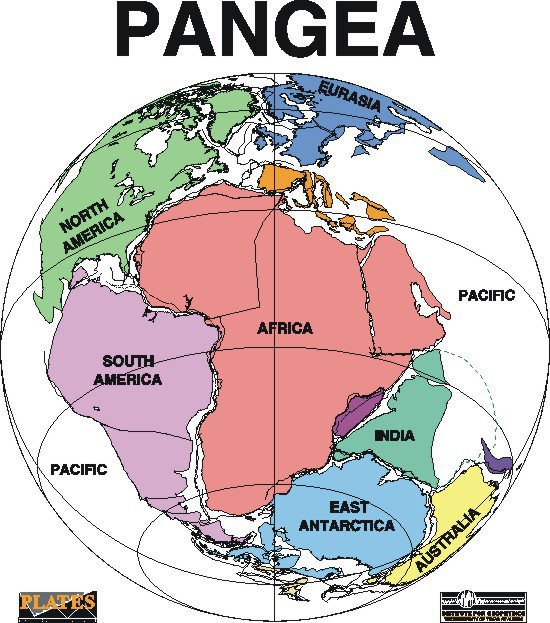
The Supercontinent Pangea. The PFNP was located near the southwestern edge of the North American continent
The Mountains….
Then, as the Rocky Mountains are built to the northeast, the land is thrust upward, exposing it to the surficial winds and waters that carve the most epic of landscapes. The Petrified Forest member of the widespread Chinle Formation, the colorful and unique formation that creates the brush stroke appearance of the Painted Desert, peeks its head out from its long slumber under the layers of sediment that buried it long ago. The trees have undergone a fossilization process known as silicification, wherein silica (SiO2) replaces organic material over long periods of time, while the rest of the landscape has undergone a process called diagenisis, or the combination of processes that renders sediment into rock.
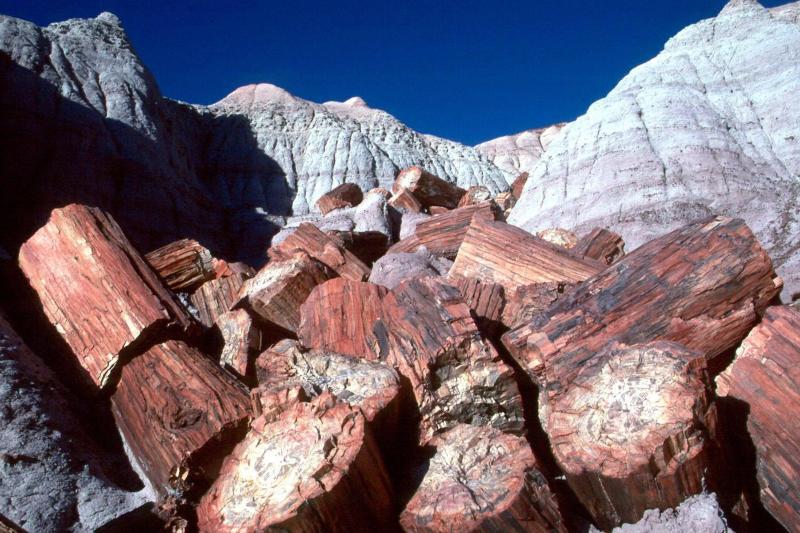
The modern-day Petrified Forest near Blue Mesa
As modern life took hold over the thousands of years of human evolution and exploration, this area was noted as special and unique, and preserved for the generations when it was designated as a National Monument in 1906, then as a National Park in 1962. Today it stands as one of the most fascinating and unique places on the face of the Earth.
Going Guided
Hiking and exploring any of the National Parks, is a special experience. Although it is possible to see these places yourself, hiring a guide is a great idea. For instance, guiding services provide logistical support, and plan everything for your best possible trip. They provide a great safety net on the trail, and are trained in backcountry medicine. Above all, they provide a depth of knowledge of the region that turns a walk into a true adventure.
Blue Marble Adventure GeoTourism provides all of the support you need, and pairs that with expert geologist/guides. Our backcountry meals use fresh ingredients, and are planned by a professional chef. Furthermore, we provide top-of-the-line gear and passion for the places we explore. In conclusion, you can visit National Parks, but going with a guide can create and even more memorable experience. Don’t be shy, and call us!
Read our blog!
For adventure hiking vacations in a geologic time machine, see our epic tours in Grand Canyon, Utah, and Arizona!
For geological musings read The Goat’s geology blog.
Follow us on Facebookand Instagram
Explore Further, Be Wild, See Through Time — Blue Marble Adventure GeoTourism

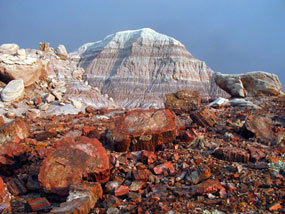
Hi. I’m glad he found bluemarbleguides.com website, I really like it, the article is very useful and
I shared it! In order to survive the hard times ahead we found
2 very good books, you can download them here: https://bit.ly/2RlAHdb and here: https://bit.ly/3e3Bg59
Great success with this site!